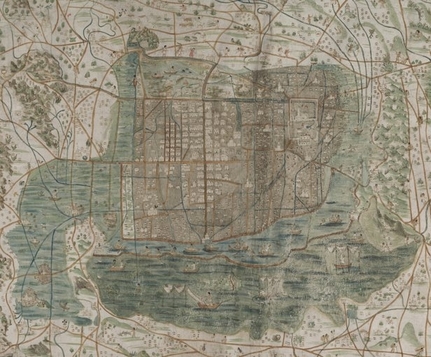
This map shows the city of Tenochtitlan which was conquered by Hernan Cortes in 1521. In present day, this map reflects similar structural elements of Tenochtitlan and Mexico City that have a close resemblance. The Spanish conquered this city and built new Spanish style buildings such as the cathedral found in the center of the map. However, they left the street layout almost identical as it was found. Once closely examined this map shows drawings of native plants, animals and shows an insight as to what the working life consisted of on a day-to-day basis. It is expected that a native, perhaps an Aztec with European schooling painted this map (“Tenochtitlan, 1521”).
The Spanish conquistadors who first arrived in 1519 at the vast city of Tenochtitlan, they were astonished at the complexity of large towers. The Great Temple of Tenochtitlan–which was the site of human sacrifice–was especially enchanting to Spanish adventurers such as Bernal Diaz (Charles 2016, 20). This was the first encounter of Spanish and the native people of Tenochtitlan. Montezuma II welcomed Cortes with immense hospitality while Cortes had other plans to seize Tenochtitlan. Cortes surrounded the city with ships in Lake Texcoco which surrounded the city. The grueling siege took over 93 days and finally, the Spanish broke through the city’s defense and ruthlessly slaughtered countless Aztecs (Hudson, 2019). After Cortes claimed Tenochtitlan as his, the Aztec Empire rapidly collapsed. Over the course of the next 3 years, the Spanish conquered Mesoamerica and named it New Spain. Smallpox worked in the favor of the Spanish, as many Aztec warriors were too ill to defend their people and ultimately, many of the Aztecs died because of their weak immune systems (Hudson, 2019).
However, it is very unfortunate that while the Aztecs wanted to accept the Spanish and have no conflicts, the Spanish leader Hernan Cortes decided that he wanted to conquer every territory in the New World. If there was no war for conquest, perhaps there would be more artifacts and more native Mexicans in today’s modern world.
Works Cited:
Chasteen, John Charles. “Encounter: Patterns of Indigenous Life.” Essay. In Born in Blood and Fire: A Concise History of Latin America, 20-21. New York, NY: W.W. Norton & Company, 2016.
Hudson, Myles. “Battle of Tenochtitlán.” Encyclopedia Britannica. Encyclopedia Britannica, inc., 2019. https://www.britannica.com/event/Battle-of-Tenochtitlan.
“Tenochtitlan, 1521.” WDL RSS. Uppsala University Library, January 1, 1970. https://www.wdl.org/en/item/503/#q=mexico.
By Giselle Rivera
